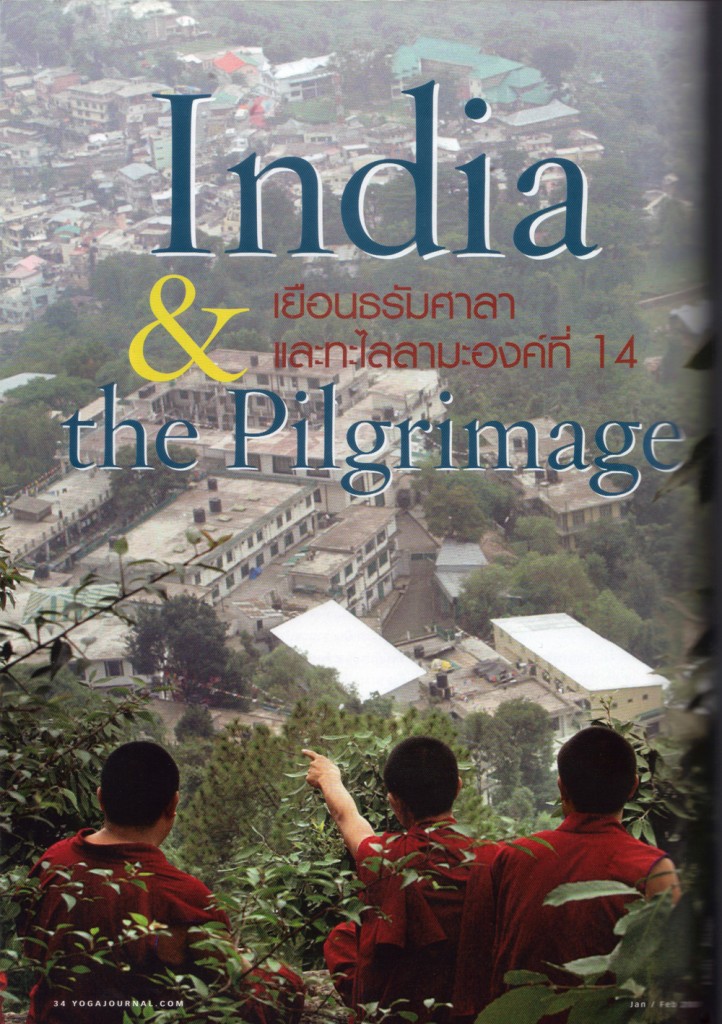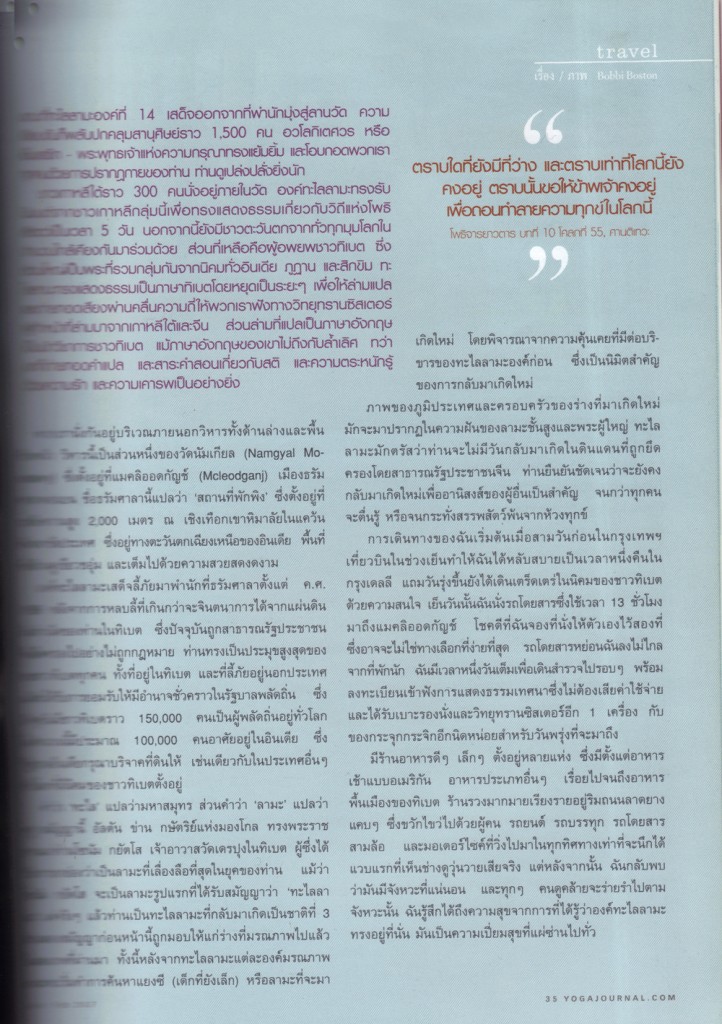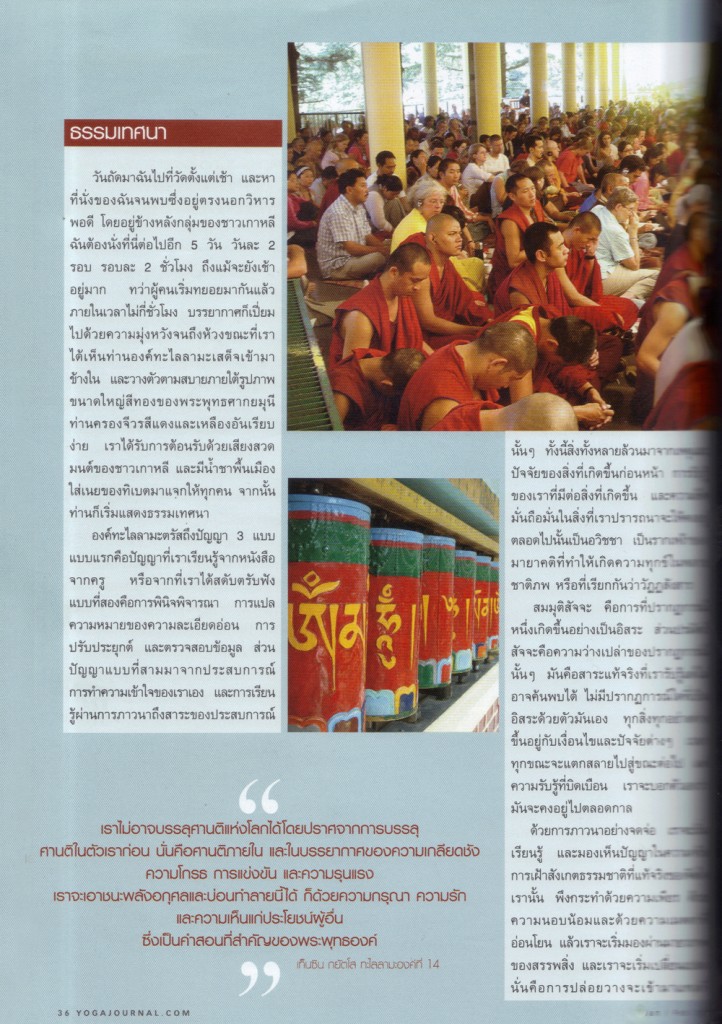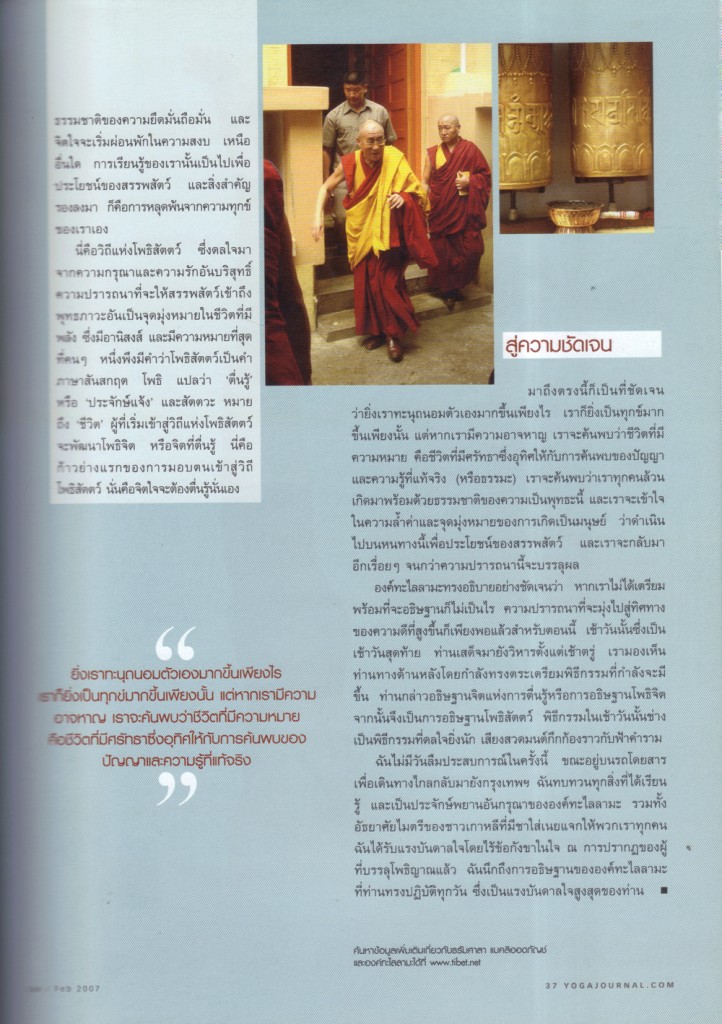
Thailand Yoga Journal – Jan/Feb 2007 – Issue 002






Article: Thailand Yoga Journal – Jan/Feb 2007 – Issue 002
THE WAY OF THE BODHISATTVA,
TEACHINGS BY HIS HOLINESS, THE XIV DALAI LAMA
Silence falls among most probably 1,500 devotees as His Holiness, The 14th Dalai Lama enters the temple grounds from his residence. The embodiment of Avaloketishvara or Chenrezig, the Buddha of compassion, smiles and embraces us all with his presence, he is radiant.
A group of South Koreans are seated inside the temple, perhaps there are 300 of them. HH is there on their request specifically to impart 5 days of teachings on the path of the Bodhisattva. Approximately the same amounts of westerners are there from every corner of the world. The remainders are Tibetan refugees in exile, most of them monks that have gathered from settlement camps all over India, Nepal, Bhutan and Sikkim. The teachings are conducted in Tibetan. A translation via designated frequencies on our transistor radios as HH pauses to allow for this time. Translators are present from South Korea and China, the English translator is a Tibetan scholar. His English is not the greatest but he translates the message of mindfulness and awareness with great love and reverence.
We are seated in the area outside the main temple space, downstairs and on the grounds in front. The temple is part of Namgyal Monastery and is located in Mcleodganj, upper Dharamsala. This is Northwestern India, the state is Himachal Pradesh and Dharamsala, which virtually translates as “place to take refuge”, is nestled at around 2,000 meters at the base of the Himalayas. It is green and beautiful.
HH has been living in exile in Dharamsala since 1959 after his unimaginable escape from his homeland of Tibet to this day illegally occupied by The Peoples Republic of China. He is the supreme leader of all Tibetans in Tibet and for all Tibetans In Exile (TIE) although he has granted temporal power to an elected government-in-exile. Presently there are over 150,000 Tibetans living in exile worldwide, 100,000 of them in India on land generously donated by the Indian Government. Similarly in the other countries of the world where there are Tibetan Settlement Camps.
“Dalai” translates as ocean and “Lama” as teacher. The actual title was first bestowed by the Mongolian ruler Altan Khan upon Sonam Gyatso, an abbot at the Drepung monastery in Tibet who was widely considered the most eminent lama of his time. Although Sonam Gyatso became the first lama to hold the title “Dalai Lama” he was actually the 3rd incarnation. The previous two titles were given to his earlier incarnations posthumously. The title “Dalai Lama” is granted to each of the spiritual leader’s successive incarnations. Upon the death of the Dalai Lama, his monks institute a search for the Lama’s reincarnation, or yangsi, a small child. Familiarity with the possessions of the previous Dalai Lama is considered the main sign of the reincarnation. Visions often come in the way of dreams to other high lamas and monks as to the geography and family of the new reincarnation. His Holiness the Dalai Lama has often stated that he will never be reborn inside territory occupied by the People’s Republic of China. He has clarified he will continue to reincarnate solely for the benefit of others until all are awakened, until the suffering of all sentient beings is no more.
My journey began 3 days prior in Bangkok. My flight in the evening afforded me a good night’s sleep in Delhi and the next day a few hours to poke around the Tibetan Camp where I was staying which was most interesting. That evening, I boarded a bus for a 13 hour journey to Mcleodganj. Gratefully I booked myself 2 seats on the bus. Perhaps not the easiest choice, but the bus deposited me a stones throw from my guest house. I had the whole day to wander around, register for the teachings which were free and to get a cushion, a transistor radio and a few other bits and pieces for the coming days.
There were great little spots to eat serving everything from American Breakfast to traditional Tibetan dishes and anything in between. Lot’s of shops lining the narrow barely paved streets that were filled to capacity with people, cars, trucks, busses, rickshaws and motorcycles all moving in every direction imaginable. At first it seemed chaotic but then I saw there was a definite rhythm and everyone seemed to be dancing to it. I could feel the sense of well being knowing His Holiness was there, it was pervasive.
THE TEACHINGS
The next day I arrive early to the monastery and find my space which is just outside the temple, behind the Koreans. I will sit here for the next five days, two two hour sessions a day. It is early still but people are already arriving. In a few hours the atmosphere is filled with anticipation for the moment we see him. He moves inside and makes himself comfortable under a huge golden image of The Buddha Sakyamuni, He is dressed humbly in his red and yellow robes. We are greeted by chanting from the Koreans and traditional Tibetan butter tea is served to all of us!
Then he begins.
Like precious stones, Buddha, Dharma and Sangha, are highly valued and taking refuge in them is the central principal to Buddhists worldwide. Take refuge in The Buddha because he is the prime source of inspiration and the ideal of Buddhahood is open to us all. Take refuge in the Dharma because it is the essential wisdom and truth. Take refuge in The Sangha, in the fellowship of others who are treading the same path, and those who embody its goal. We take refuge for the comfort and sense of safety we find there. Like a baby resting in the arms of its loving mother, so too we rest in The Three Jewels.
He talks about three types of wisdom, what we learn from a book, a teacher or what we hear along the way; how then we contemplate, decipher the sensibility, the application, examine the information; thirdly, the experiential quality, having our own understanding and learning through meditation the essence of the experience. That all occurrence is based on the causes and conditions of previous occurrence. Our perception of that occurrence, and our attachment to what we want to remain forever, or our aversion to what makes us uncomfortable, is ignorance and the root of our delusion which leads to lifetimes of suffering. This is known as conditioned existence or samsara-the state of unenlightenment.
The conventional reality is how phenomenon appears to be independent. The ultimate reality is its emptiness. The actual content of what we perceive is unfindable. Sort of like the car is an assembly of parts. But what makes those parts into a car is difficult to explain. When do the parts finally become a car? Is it when it performs the functions of a car? Is it no longer a car when it won’t start? And there is no phenomenon that is independent of another. Everything depends on other conditions and factors. Every moment disintegrates into the next, our distorted perception tells us this is everlasting.
Through vigilant meditation we can begin to learn, or to unlearn and see the wisdom in this truth. Observe with patience, humility and gentle loving kindness the true nature of our minds. We begin to see past this delusion of the way things appear, and we begin to change. A sort of letting go replaces this grasping nature and the mind begins to rest in calm abiding. Above all, what is most important is that we learn this for the benefit of all “sentient”, or sensorial beings. And that our own liberation from suffering is only secondary in significance to theirs.
This is the path of the Bodhisattva, motivated by pure compassion and love. The desire to seek Buddhahood for all sentient beings is the most powerful, beneficial and meaningful purpose one can have in their life. Bodhisattva is a Sanskrit term – “Bodhi” awakened or enlightened and “Sattva” being. When someone first enters the way of the Bodhisattva, they develop Bodhicitta, or, awakening mind. This is the first step to committing to the Bodhisattva way, the mind must become enlightened.
THE PERFECTIONS
We learn of the “paramitas”, or The Six Perfections. Santideva’s description of the Boddhisattva’s means by which they may attain their goal of awakening for the sake of all beings. He is clear on the importance of practicing the paramitas in order.
- Generosity – Giving unconditionally not only in matters of finance but in every aspect of being. Cultivation of compassion, kindness, gratitude and sympathetic joy. Virtuous actions that appose self – centeredness result in a profound sense of selflessness.
- Ethical morality and discipline –Refrain from doing harm to yourself and all those around you. Reject killing, sexual misconduct, consuming harmful substances such as alcohol or drugs, being deceitful, gossip, lying, ill will and using abusive language. All harm begins in the mind therefore the mind must be aware at all times of the nature of its thoughts.
- Patience –The antidote to anger which is the most unskillful state of mind. It makes impossible the task to do good deeds and leads us into fear and loneliness. Patience creates harmony within us. With patience comes true understanding and tolerance of all beings. With patience, resentment dissolves.
- Perseverance – Enthusiasm and a sense of urgency. Great effort is needed to guard mindfulness and awareness. Constantly examine the contents of mind insuring it is free from chaos. Effort creates process. Laziness leads to inactivity which leaves an opening for words, deeds and actions that can have adverse consequences.
- Concentration –Focus single-pointedly on one object with a non-wavering mind. The calm-abiding mind develops clairvoyance and abilities to heal ourselves and others. Concentration is a form of mindfulness and allows introspection which creates space for disturbing emotions to subside.
- Wisdom – The source of all great qualities we can cultivate in this life. As the Sixth Perfection, it is the total of the other five. It is essential to understand and experience selflessness, impermanence and emptiness.
CLARITY
Here it becomes clear that the more we cherish self, the more we suffer. But if we are courageous, we discover that a meaningful life is a life of faith devoted to the discovery of true wisdom and knowledge, The Dharma. That we are all born with this Buddha Nature and that by cultivating Bodhichitta we begin to return there. We understand the preciousness and purpose of human birth is to practice this path for the greater benefit of all beings. And we are willing to return again and again to see this desire fulfilled.
His Holiness makes it clear that if we are not prepared to take such a vow, it is ok. The aspiration to move in the direction of the greater good is enough for now. That morning, the last morning, he came to the temple very early; we could all see him in the back preparing for the events to come. He imparts The Vow of Awakening Mind or Bodhichitta Vow, then the actual Vow of the Bodhisattva. It is a very moving ceremony. The chanting is like thunder.
The teachings were taken from 3 important texts. Bodhicharyavatara-The Path of the Bodhisattva by the great 8th century Indian Buddhist monk and Sanskrit poet, Shantideva. This text and particularly chapter 9 supplies many of the ideals and practices for Tibetan Buddhism, although most of the text was covered in the teachings, it primarily focused on chapter 9 which dealt with the difficult concept of emptiness, The perfection of Wisdom. The 37 Practices of a Bodhisattva, by 13th century Ngolchu Thogme Rinpoche. This text is on the Mahayana practice of developing Bodhicitta and living one’s life as a Bodhisattva. It is recommended to read daily. Mulamadhyamakakarika-The Fundamental Wisdom of The Middle Way, by 2nd century philosopher Nagarjuna. The teachings focused on chapters 18, 22, 24 and 26.
This experience is one I will never forget, as I get on the bus to make the long journey back to Bangkok I reflect on all that I have learned and witnessed. The generous hospitality of His Holiness and of the Koreans, that butter tea was served every morning and milk tea was served every afternoon to all of us. To those that stayed during the break, lunch was also served. I was so touched by these gestures. I have been inspired and in the presence of an enlightened being, no doubt in my mind. I think about the vow His Holiness takes everyday and is his highest inspiration.
“As long as space abides and as long as the world abides, so long may I abide, destroying the sufferings of the world” Santideva, Bodhicharyavatara, chapter 10, verse 55
“We cannot achieve world peace without first achieving peace within ourselves; inner peace. In an atmosphere of hatred, anger, competition and violence, no lasting peace can be achieved. These negative and destructive forces must be overcome by compassion, love and altruism, which are the essential teachings of The Buddha”
Tenzin Gyatso, H.H. the XIV Dalai Lama
Written with great challenge, love and joy by Bobbi Boston 24 August 2006
For more information on Dharamsala, Mcleodganj and His Holiness The Dalai Lama please check www.tibet.net
Bobbi Boston was born in New York in 1957 and was raised in Los Angeles. She married and joined her husband in Las Vegas and stayed there for 7 years. It was during this time that she began the inward shift in her life with the discovery of Ashtanga Yoga in 1997 which ultimately led to a move to Australia and then Thailand. Shortly thereafter she discovered Vipassana Meditation. In 2001 she closed her design business of 15 years and started teaching yoga full time so she could immerse herself in this world that had become her teacher. “My life has just been a constant unraveling of this idea I had of myself. First through Asana, which allowed me to play out anxious and fearful situations and ultimately walk through them by physical practice. Then with meditation, familiarizing myself with my mind, my judgments there and seeing how terrified I was and how I protected that apprehension by constantly being on the defensive. On a trip to Tibet I was introduced to Tibetan Buddhism. It resonated with me in such a way, it just felt familiar. I really don’t have to worry about myself at all. I just need to be of service, any way possible, to show up to the responsibilities of life and respect it for all its’ gifts and tricks. I can wink at my attachments and snarl at my aversions, all very tongue in cheek. Understanding the serious consequence of suffering when I don’t see things the way they are, for what they are.” Her other interests are in the study of Ayurvedic Medicine and Therapeutic Yoga for the very young.